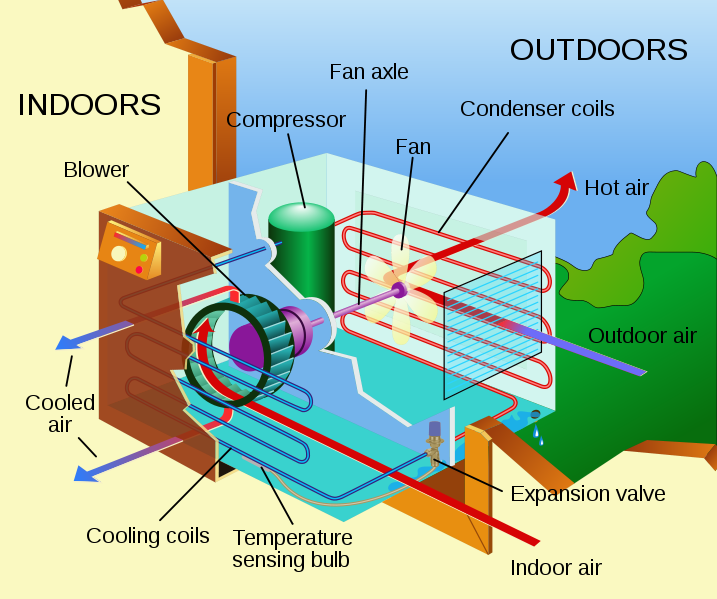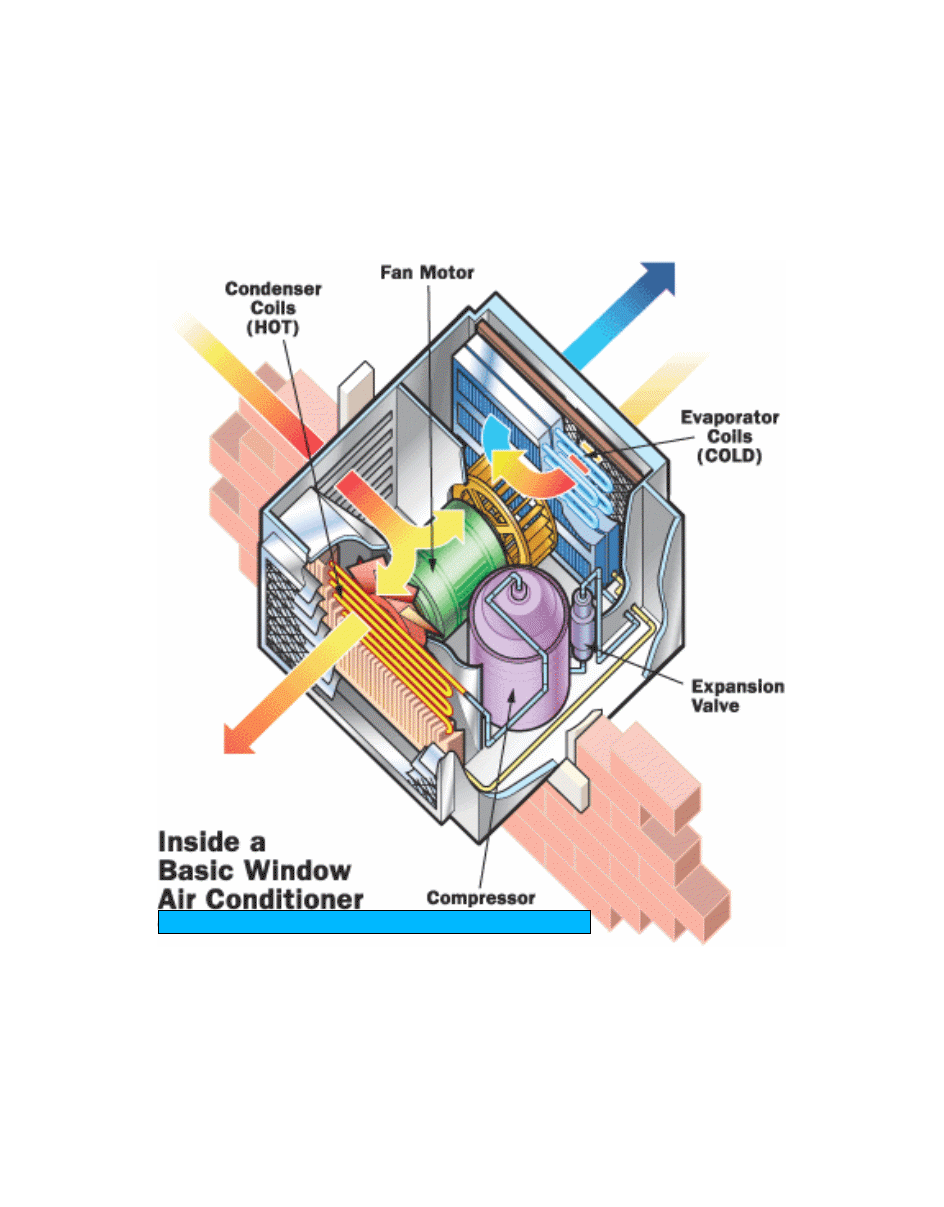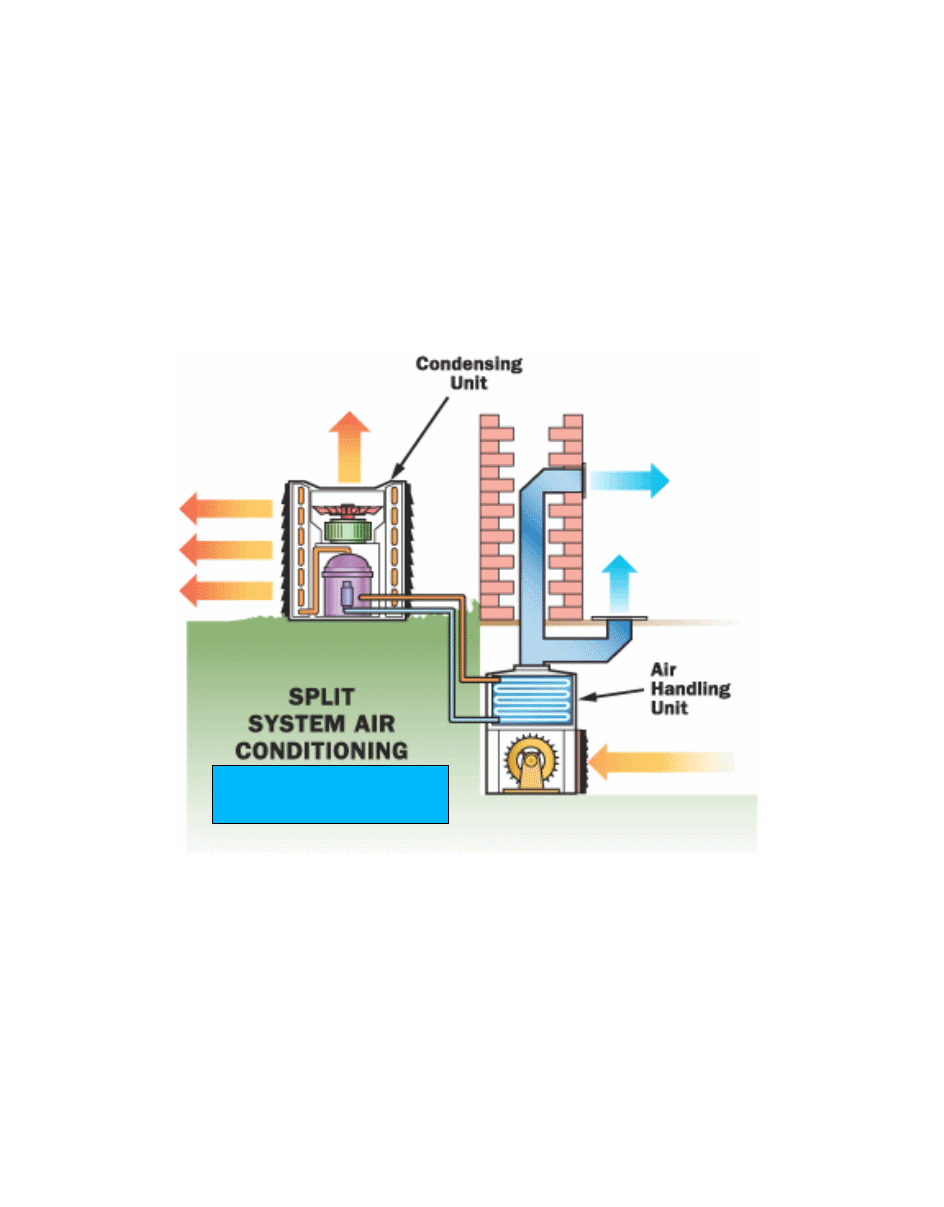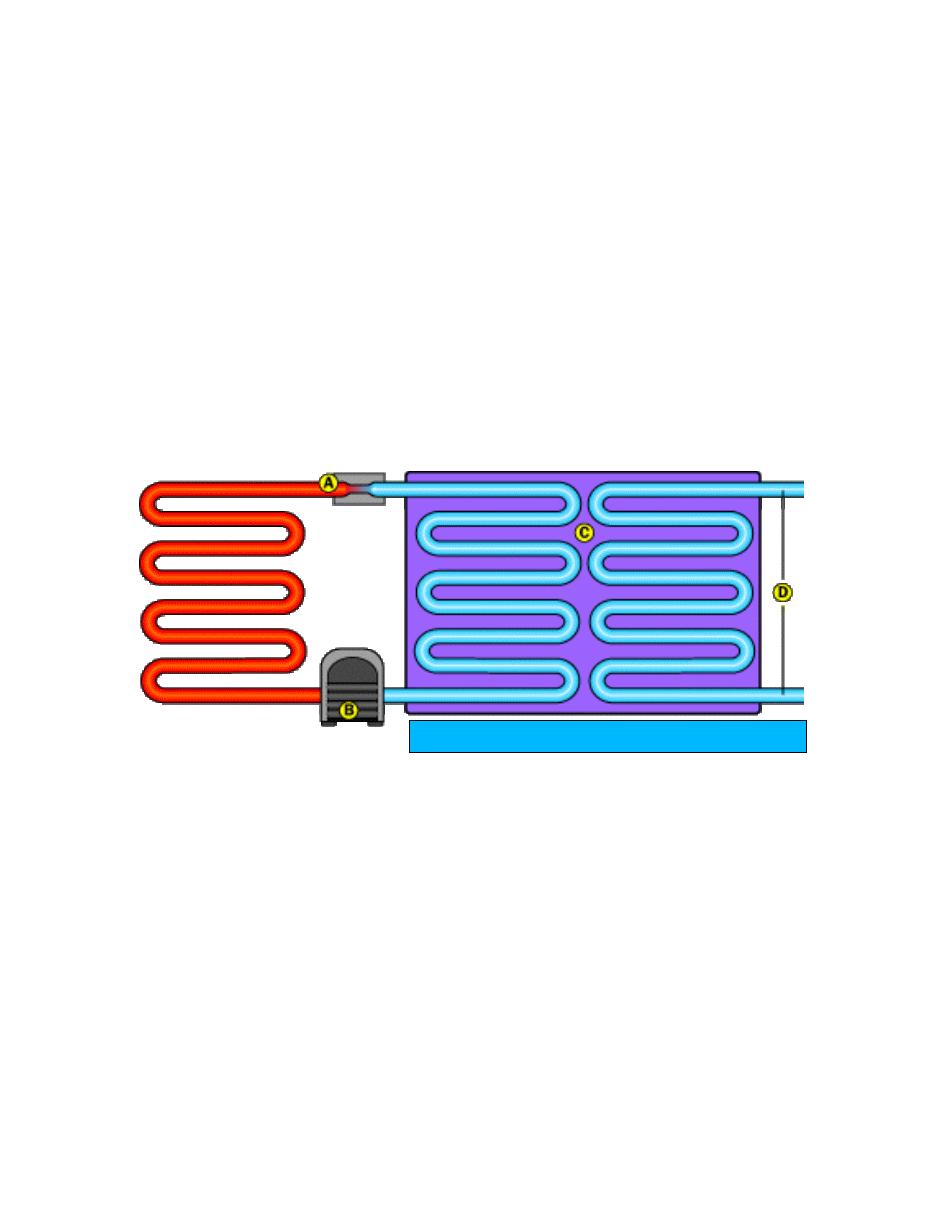Air Conditioners
Heating, Ventilation, Air Conditioning and Refrigeration (HVAC/R)
| Room temperature is a general term describing common indoor temperatures. It is usually 20 °C (68 °F or 293 K). |
|
Take a look at this. Heat wave harms http://www.qureshiuniversity.com/heatwaveharms.html Take a look at this. Cold wave harms http://www.qureshiuniversity.com/emergencyworld.html |

|
| Window Air Conditioners |
| Aircraft Air Conditioning |
| Automobile air conditioning |
| Ice storage air conditioning |
| Free cooling |
| Ground-coupled heat exchanger |
| HVAC |
| Seawater air conditioning |
| Learn to Troubleshooting HVAC and Air Conditioner with Your Senses |
| Heating, Ventilation, Air Conditioning and Refrigeration (HVAC/R) |
| Thermoelectric effect |
|
What is Air Conditioning? How does an air conditioner work? What is the best thermostat to use for my cooling system? |
 |
| What is Air Conditioning? |
| Air conditioner |
| Air conditioning |
|
How does an air conditioner work? An air conditioner seems as if it cools your home's air, but it actually makes your home less warm by removing heat from the indoor air and transferring that heat to the outdoor air. Heat is extracted from the home by passing indoor air across a refrigerant coil in the indoor unit. Refrigerant lines then carry the heat to the outdoor unit, where it is released into the outside air. The cooling cycle continues until the indoor temperature reaches the thermostat setting. Can frost, ice, dirt or other debris keep the outdoor unit of my cooling system from operating effectively? Select Lennox cooling products are specifically designed to deal with harsh weather conditions and debris buildup. The outdoor units of the XP21 and XP17 heat pumps and the XC21 and XC17 air conditioners all include the exclusive SilentComfort™ fan motor, which senses the buildup of frost, ice or dirt on any part of the fan assembly. If such buildup occurs, the motor automatically compensates by operating at a higher starting torque and alternating the rotational direction of the fan to allow its specially designed composite fan blades to break up the debris. The fan motor then resumes normal operation, keeping the air conditioner or heat pump running at peak efficiency. What is the best thermostat to use for my cooling system? Choosing the right thermostat to control operation of your cooling system depends a lot on the equipment you have. Lennox offers a complete line of thermostats, both programmable and non-programmable models, each designed to maximize the performance of your heating system. Your Lennox Dealer will help you choose the thermostat best suited to your needs. The icomfort Touch® is our most user-friendly programmable thermostat yet. It acts as the "brain" of the icomfort by Lennox™ system, sensing the environment and optimizing Dave Lennox Signature® Collection flagship products to deliver the highest level of comfort, energy efficiency and overall performance. Lennox ComfortSense® 7000 Series thermostat is designed with intuitive touchscreen operation and flexible programming options to enhance the performance and efficiency of your heating and cooling systems. ComfortSense 7000 Series thermostats can also be used with a dual-fuel system. The ComfortSense® 5000 Series touchscreen thermostat is another of our programmable models, and is compatible with almost any heating system. This thermostat is unique in that it mounts directly to a wall, but can be easily removed for remote programming. ComfortSense® 3000 Series thermostats are available in programmable models that allow you to customize temperature settings for weekdays and weekends, with a value-priced, non-programmable model also available for use in basic applications. When the temperature outside begins to climb, many people seek the cool comfort of indoor air conditioning. Like water towers and power lines, air conditioners are one of those things that we see every day but seldom pay much attention to. Wouldn't it be nice to know how these indispensable machines work their magic? Air conditioners come in various sizes, cooling capacities and prices. One type that we see all the time is the window air conditioner, an easy and economical way to cool a small area: ac People who live in suburban areas usually have a condenser unit in the backyard: ac If you live in an apartment complex, you'll probably see multiple condensers for each dwelling: ac Most businesses and office buildings have condensing units on their roofs, and as you fly into any airport you notice that warehouses and malls may have 10 or 20 condensing units hidden on their roofs: ac At office complexes, you'll find large cooling towers that are connected to the air conditioning system: ac Even though each of these machines has a pretty distinct look, they all work on the same principles. In this article, we'll examine air conditioners -- from small to huge -- so you know more about what you're seeing. We'll also look at some new, energy-efficient cooling methods. Air-conditioning Basics Most people think that air conditioners lower the temperature in their homes simply by pumping cool air in. What's really happening is the warm air from your house is being removed and cycled back in as cooler air. This cycle continues until your thermostat reaches the desired temperature. An air conditioner is basically a refrigerator without the insulated box. It uses the evaporation of a refrigerant, like Freon, to provide cooling. The mechanics of the Freon evaporation cycle are the same in a refrigerator as in an air conditioner. According to the Merriam-Webster Dictionary Online, the term Freon is generically "used for any of various nonflammable fluorocarbons used as refrigerants and as propellants for aerosols." ac Diagram of a typical air conditioner. This is how the evaporation cycle in an air conditioner works (See How Refrigerators Work for complete details on this cycle): 1. The compressor compresses cool Freon gas, causing it to become hot, high-pressure Freon gas (red in the diagram above). 2. This hot gas runs through a set of coils so it can dissipate its heat, and it condenses into a liquid. 3. The Freon liquid runs through an expansion valve, and in the process it evaporates to become cold, low-pressure Freon gas (light blue in the diagram above). 4. This cold gas runs through a set of coils that allow the gas to absorb heat and cool down the air inside the building. Mixed in with the Freon is a small amount of lightweight oil. This oil lubricates the compressor. Air conditioners help clean your home's air as well. Most indoor units have filters that catch dust, pollen, mold spores and other allergens as well as smoke and everyday dirt found in the air. Most air conditioners also function as dehumidifiers. They take excess water from the air and use it to help cool the unit before getting rid of the water through a hose to the outside. Other units use the condensed moisture to improve efficiency by routing the cooled water back into the system to be reused. So this is the general concept involved in air conditioning. In the next section, we'll take a look at window and split-system units. Window and Split-system AC Units A window air conditioner unit implements a complete air conditioner in a small space. The units are made small enough to fit into a standard window frame. You close the window down on the unit, plug it in and turn it on to get cool air. If you take the cover off of an unplugged window unit, you'll find that it contains: * A compressor * An expansion valve * A hot coil (on the outside) * A chilled coil (on the inside) * Two fans * A control unit The fans blow air over the coils to improve their ability to dissipate heat (to the outside air) and cold (to the room being cooled). ac When you get into larger air-conditioning applications, its time to start looking at split-system units. A split-system air conditioner splits the hot side from the cold side of the system, like this: ac The cold side, consisting of the expansion valve and the cold coil, is generally placed into a furnace or some other air handler. The air handler blows air through the coil and routes the air throughout the building using a series of ducts. The hot side, known as the condensing unit, lives outside the building. The unit consists of a long, spiral coil shaped like a cylinder. Inside the coil is a fan, to blow air through the coil, along with a weather-resistant compressor and some control logic. This approach has evolved over the years because it's low-cost, and also because it normally results in reduced noise inside the house (at the expense of increased noise outside the house). Other than the fact that the hot and cold sides are split apart and the capacity is higher (making the coils and compressor larger), there's no difference between a split-system and a window air conditioner. In warehouses, large business offices, malls, big department stores and other sizeable buildings, the condensing unit normally lives on the roof and can be quite massive. Alternatively, there may be many smaller units on the roof, each attached inside to a small air handler that cools a specific zone in the building. In larger buildings and particularly in multi-story buildings, the split-system approach begins to run into problems. Either running the pipe between the condenser and the air handler exceeds distance limitations (runs that are too long start to cause lubrication difficulties in the compressor), or the amount of duct work and the length of ducts becomes unmanageable. At this point, it's time to think about a chilled-water system.   Chilled-water and Cooling-tower AC Units In a chilled-water system, the entire air conditioner lives on the roof or behind the building. It cools water to between 40 and 45 degrees Fahrenheit (4.4 and 7.2 degrees Celsius). This chilled water is then piped throughout the building and connected to air handlers as needed. There's no practical limit to the length of a chilled-water pipe if it's well-insulated. ac You can see in this diagram that the air conditioner (on the left) is completely standard. The heat exchanger lets the cold Freon chill the water that runs throughout the building. In all of the systems described earlier, air is used to dissipate the heat from the outside coil. In large systems, the efficiency can be improved significantly by using a cooling tower. The cooling tower creates a stream of lower-temperature water. This water runs through a heat exchanger and cools the hot coils of the air conditioner unit. It costs more to buy the system initially, but the energy savings can be significant over time (especially in areas with low humidity), so the system pays for itself fairly quickly. 1. Cooling towers come in all shapes and sizes. They all work on the same principle: 2. A cooling tower blows air through a stream of water so that some of the water evaporates. 3. Generally, the water trickles through a thick sheet of open plastic mesh. 4. Air blows through the mesh at right angles to the water flow. 5. The evaporation cools the stream of water. 6. Because some of the water is lost to evaporation, the cooling tower constantly adds water to the system to make up the difference. ac Cooling Towers The amount of cooling that you get from a cooling tower depends on the relative humidity of the air and the barometric pressure. For example, assuming a 95-degree Fahrenheit (35-degree Celsius) day, barometric pressure of 29.92 inches (sea-level normal pressure) and 80-percent humidity, the temperature of the water in the cooling tower will drop about 6 degrees to 89 degrees Fahrenheit (3.36 degrees to 31.7 degrees Celsius). If the humidity is 50 percent, then the water temperature will drop perhaps 15 degrees to 80 degrees Fahrenheit (8.4 degrees to 26.7 degrees Celsius). And, if the humidity is 20 percent, then the water temperature will drop about 28 degrees to 67 degrees Fahrenheit (15.7 degrees to 19.4 degrees Celsius). Even small temperature drops can have a significant effect on energy consumption. Whenever you walk behind a building and find a unit that has large quantities of water running through a thick sheet of plastic mesh, you will know you have found a cooling tower! In many office complexes and college campuses, cooling towers and air conditioning equipment are centralized, and chilled water is routed to all of the buildings through miles of underground pipes. In the next section, we'll look at how much all this cooling power costs.  BTU and EER Most air conditioners have their capacity rated in British thermal units (BTU). Generally speaking, a BTU is the amount of heat required to raise the temperature of one pound (0.45 kg) of water 1 degree Fahrenheit (0.56 degrees Celsius). Specifically, 1 BTU equals 1,055 joules. In heating and cooling terms, 1 "ton" equals 12,000 BTU. A typical window air conditioner might be rated at 10,000 BTU. For comparison, a typical 2,000-square-foot (185.8 m2) house might have a 5-ton (60,000-BTU) air conditioning system, implying that you might need perhaps 30 BTU per square foot. (Keep in mind that these are rough estimates. To size an air conditioner for your specific needs, contact an HVAC contractor.) The energy efficiency rating (EER) of an air conditioner is its BTU rating over its wattage. For example, if a 10,000-BTU air conditioner consumes 1,200 watts, its EER is 8.3 (10,000 BTU/1,200 watts). Obviously, you would like the EER to be as high as possible, but normally a higher EER is accompanied by a higher price. Let's say that you have a choice between two 10,000-BTU units. One has an EER of 8.3 and consumes 1,200 watts, and the other has an EER of 10 and consumes 1,000 watts. Let's also say that the price difference is $100. To understand what the payback period is on the more expensive unit, you need to know approximately how many hours per year you will be operating the unit and How much a kilowatt-hour (kWh) costs in your area Let's say that you plan to use the air conditioner in the summer (four months a year) and it will be operating about six hours a day. Let's also imagine that the cost in your area is $0.10/kWh. The difference in energy consumption between the two units is 200 watts, which means that every five hours the less expensive unit will consume 1 additional kWh (and therefore $0.10 more) than the more expensive unit. Assuming that there are 30 days in a month, you find that during the summer you're operating the air conditioner: 4 mo. x 30 days/mo. x 6 hr/day = 720 hours [(720 hrs x 200 watts) / (1000 watts/kW)] x $0.10/kWh = $14.40 The more expensive unit costs $100 more, which means that it will take about seven years for the more expensive unit to break even. See Climate Magic for a great explanation of seasonal energy efficiency rating (SEER). In the next section, we'll look at cutting these costs with some new, energy-efficient cooling systems. Energy Efficient Cooling Systems Passive Cooling Some people go to the extreme and get rid of their AC units entirely. Passive cooling is the greenest of trends and a great way to save money. Passive cooling revolves around the concept of removing warm air from your home using the interaction between the house and its surroundings. There are several ways to block and remove heat, including shading through landscaping, using a dark exterior paint, installing a radiant barrier in the roof rafters and good old- fashioned insulation. Another way is through thermal siphoning, the process of removing heat through controlled airflow. Opening the lower windows on the breezy side of your house and the upper windows on the opposite side creates a vacuum that draws out the hot air. Ceiling fans and roof vents are other ways to direct heat out at low cost [source: Earth Easy]. Because of the rising costs of electricity and a growing trend to "go green," more people are turning to alternative cooling methods to spare their pocketbooks and the environment. Big businesses are even jumping on board in an effort to improve their public image and lower their overhead. Ice cooling systems are one way that businesses are combating high electricity costs during the summer. Ice cooling is as simple as it sounds. Large tanks of water freeze into ice at night, when energy demands are lower. The next day, a system much like a conventional air conditioner pumps the cool air from the ice into the building. Ice cooling saves money, cuts pollution, eases the strain on the power grid and can be used alongside traditional systems. The downside of ice cooling is that the systems are expensive to install and require a lot of space. Even with the high startup costs, more than 3,000 systems are in use worldwide [source: CNN]. You can read more about ice cooling in Are Ice Blocks Better than Air Conditioning? An ice cooling system is a great way to save money and conserve energy, but its price tag and space requirements limit it to large buildings. One way that homeowners can save on energy costs is by installing geo-thermal heating and cooling systems, also known as ground source heat pumps (GSHP). The Environmental Protection Agency recently named geo-thermal units "the most energy-efficient and environmentally sensitive of all space conditioning systems" [source: EPA]. Although it varies, at six feet underground the Earth's temperatures range from 45 to 75 degrees Fahrenheit. The basic principle behind geo-thermal cooling is to use this constant temperature as a heat source instead of generating heat with electricity. The most common type of geo-thermal unit for homes is the closed-loop system. Polyethylene pipes are buried under the ground, either vertically like a well or horizontally in three- to six-foot trenches. They can also be buried under ponds. Water or an anti-freeze/water mixture is pumped through the pipes. During the winter, the fluid collects heat from the earth and carries it through the system and into the building. During the summer, the system reverses itself to cool the building by pulling heat from the building, carrying it through the system and placing it in the ground. |
